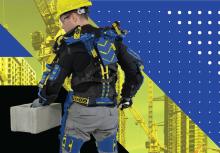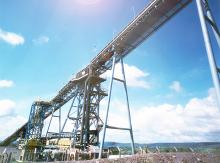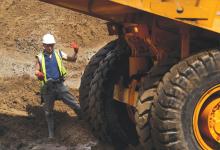
Exoskeletons are not yet part of quarry workers’ dress code, but that could soon change, argues Gareth Bendelow, Technical Director at HSB Engineering Insurance.
Back in 1986, when Sigourney Weaver fought with the queen alien wearing the exoskeleton
For those who are not familiar with the term, an exoskeleton is a device which is used or worn by a human to amplify their input force or assist in their movement; hence the alternative name sometimes used is Human Amplified Robotic Systems. These machines are usually worn on parts or all of the body and although the word exoskeleton, for some, may conjure images of mechanised soldiers in computer games, the reality is quite different.
The concept of machines worn by humans to assist in work tasks is not a new one, as the first idea for a mechanical suit dates back to 1890 and was the brainchild of a Russian named Nicholas Yagn. His system used the concept of compressed air bags to store energy which could be used to assist movement in human actions. The development of these types of devices accelerated in the 1960’s, initially by the military to assist soldiers in lifting and carry loads. These machines utilised electric hydraulic systems for movement and enabled the user to amplify their strength by a factor of 25. However the total weight of the machine was circa 680kg making it impractical for use.
The development of the exoskeleton has continued as materials technology has evolved, along with the leaps in computer processing power and battery technology. Since the 1960’s, the potential use of these machines has moved from the narrow field of the military to more general applications. Japan has researched heavily into exoskeletons for medical use, with research facilities developing exoskeletons which can to be worn by disabled persons to assist with their movement.
We have now come to a point, where due to cost and size, it will not be too long before we find the exoskeleton used in the general work environment. It has been reported that Panasonic (through its subsidiary Activelink) are planning to manufacture the first batch of 1000 exoskeleton units in 2015 at a cost of around US$5,000 each. This type of unit will enable a person to lift a 100kg load and move around at 8kph. The units are planned to be sold as a base platform for experiments with possible uses for search and rescue along with dangerous material handling. Given the relatively low cost and potential availability it should not be too long before these have a practical application in the workplace, such as an alternative to the light duties of forklift trucks.
In areas such as quarry work there may be possible opportunities in the future for easing manual handling duties, such as the manual movement of bags of aggregate. For general retail purposes, bags of aggregate and cements are sized at 25kg, the loading and handling of these bags can be a manual process therefore the use of a wearable muscle suit may increase lifting capacity for the aggregate workers (maybe 2 bags per lift) and possibly reduce fatigue and the risk of injury.
From an insurance point of view this means that the exoskeleton could easily be classified as a lifting device, with a need for inspection and equipment damage cover. However, for exoskeletons to be considered as proven technology, insurers will be keen to obtain as much usage data as possible including the number of hours of use, the experience and training of the users and recognition of any problems that might occur. Safety examinations are likely to be vital from an insurance risk perspective, with the likelihood of regular inspections being necessary. Competent and experienced inspectors would be needed for this role.
Whilst these machines have been confined to experimental facilities for many years it may not be too long before we find exoskeletons listed on a plant schedule and in active use on quarry sites and in associated production areas.








